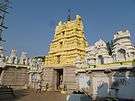Kanakachalapathi Temple, Kanakagiri
The Kanakachalapathi temple is a 16th-century Hindu temple dedicated to the god Vishnu. It is located in the town of Kanakagiri, in the Gangavathi taluk of Koppal district in the Karnataka state, India. Kanakagiri, known in ancient times as "Swarnagiri" (lit, "Hill of Gold") is about 3 km from the district headquarters Koppal city, 380 km north of Bangalore city and 200 km east of Belagavi city.
Kanakachalapathi temple | |
|---|---|
Hindu Temple | |
Kanakachalapathi temple (16th century) | |
 Kanakachalapathi temple Location in Karnataka, India | |
| Coordinates: 15°33′N 76°24′E | |
| Country | |
| State | Karnataka |
| District | Koppal |
| Languages | |
| • Official | Kannada |
| Time zone | UTC+5:30 (IST) |
| PIN | 583283 |
| Nearest city | Gangavathi |
| Website | www.kanakagiri.in |
Kanakagiri is known to get its present name from Kanaka Muni, a Hindu saint who performed penance there. The historically important Koppal city, known in ancient inscriptions as Kopana is also of archeological significance due to the discovery of two inscriptions from the rule of Emperor Ashoka (3rd ceneutry B.C.E.) at the nearby villages Palkigundu and Gavimatha. After the end of the Maurya Empire rule over the region when Koppal had been a southern viceroyalty, Koppal passed into the hands of notable dynasties of the Deccan: the Satavahana dynasty, the Western Ganga Dynasty, the Hoysalas and the Chalukya dynasty. The earliest available Kannada classic, the Kavirajamarga of King Nrupatunga Amoghavarsha I (r.814-878 A.D.), mentions Koppal in the sentence Viditha Maha Kopana Nagara.[1][2]
The Kanakachalapathi temple is an example of Dravidian architecture of the Vijayanagara era. It is a protected monument under the Karnataka state division of the Archaeological Survey of India.[1][3] The temple was built by the ruling vassal polyagar (Nayaka or feudal lord). The temple complex is a large one with spacious halls (mantapa) and massive Yali pillars. There a three well executed, tiered gopuras (tower over entrance) over as many entrances. Sculpture in the temple includes those of mythological figures in wood and pilaster, and that of kings and queens in black stone. The popularity of the temple is supported by a local saying: "people with eyes must see Kanakagiri and those with legs, Hampi", an affirmation that the Kanakachalapathi temple is a delight to the eyes where as one needs to tread tirelessly to enjoy the architectural wonders of near by Hampi (UNESCO World heritage cite), the royal centre of Vijayanagara, the capital of the Vijayanagara empire. In the months of February and March, during the Phalguna season, the temple hosts a popular fair called the "Kanakachalapathi fair" (Jatra) .[1][2]
References
- "Koppal". Karnataka.com. Retrieved 4 June 2015.
- "Places of Interest in Koppal district". Department of Tourism, Government of Karnataka. Archived from the original on 4 March 2016. Retrieved 4 June 2015.
- "Protected Monuments in Karnataka". Archaeological Survey of India, Government of India. Indira Gandhi National Center for the Arts. Retrieved 4 June 2015.
Gallery
 View from the rear of the Kanakachalapathi temple at Kanakagiri
View from the rear of the Kanakachalapathi temple at Kanakagiri Spacious open mantapa of Kanakachalapathi temple at Kanakagiri
Spacious open mantapa of Kanakachalapathi temple at Kanakagiri Pilaster dolls adorn the ceiling over the mantapa in the Kanakachalapathi temple at Kanakagiri
Pilaster dolls adorn the ceiling over the mantapa in the Kanakachalapathi temple at Kanakagiri View of the tower over main entrance from within the courtyard of Kanakachalapathi temple at Kanakagiri
View of the tower over main entrance from within the courtyard of Kanakachalapathi temple at Kanakagiri- Yali pillars in the Kanakachalapathi temple at Kanakagiri
- View from the courtyard looking in to the open mantapa of Kanakachalapathi temple at Kanakagiri
- Large open mantapa with Yali pillars in the Kanakachalapathi temple at Kanakagiri
- Rear view of the Kanakachalapathi temple at Kanakagiri
- 16th century Kannada inscription in the Kanakachalapathi temple at Kanakagiri